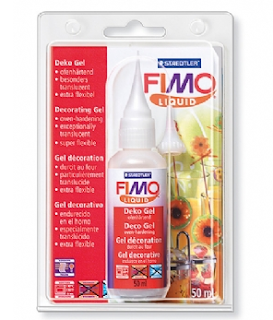Liquid clay is a useful and versatile addition to the world of polymer clay. It works well as a primary medium when colored with oil-based paint, alcohol inks, or powdered pigments such as Pearl Ex powders. When coloring liquid clay mix only a drop or two at a time until you reach the desired color. It's easy to add too much color and ruin your results.
Here are a few uses for liquid polymer clay:
*It can be used as an adhesive to bond layers or pieces of clay together. This works with baked or unbaked clay.
*You can use it to make image transfers.
This image is linked to a tutorial for making butterfly wings using Translucent Liquid Sculpey
*You can add inclusions such as mica powders, glitter, or fibers to the liquid clay to create unique effects.
*You can use it to seal foils, leafing, and transfers.
*You can even use it to laminate paper.
One nice thing about liquid clay is that it's self leveling. However, when using it as a sealer be sure not to apply it too thickly or you could end up with a cloudy finish. You can sand or buff the liquid clay after baking to polish and add clarity to the finish. You can make the surface more shiny by applying glaze to cured liquid clay.
Applying Liquid Clay
You can pour liquid clay directly from the bottle or use a toothpick, finger tip, or brush for detailed applications. If using a brush, a high quality hair or synthetic brush works best. Cheaper brushes may lose bristles in the liquid clay. Any brush that's used to apply liquid clay must remain dedicated to that use since you won't be able to clean the liquid clay from the brush.
To care for these brushes wipe the excess clay out of the bristles with a paper towel, stroking the towel in the direction of the bristles, away from the handle. Cover the brushes with a small plastic bag with the handle facing down when stored, This keeps dust and debris out of the brush. Liquid clay can be cleaned up with baby wipes or alcohol.
After a while the liquid clay in the brush may begin to thicken and firm up. To recondition the brush work a few drops of liquid clay into the bristles to soften them. Then drag the tip of a toothpick through the bristles to removes the excess clay. Wipe the bristles with a paper towel and repeat as needed.
You can also use a heat gun to sure liquid clay. You can see when the clay has set: the sheen will disappear indicating that the clay has cured.
Brands of Liquid Clay
Fimo Liquid Decorating Gel comes in a 2 oz. bottle and is the clearest of the liquid clays. It has the lowest viscosity and is very flexible after baking. Thick layers will give you a satiny gloss finish and extremely thin layers give you a matte finish.
Kato Liquid Polyclay is available in 2 oz. and 8 oz. bottles and offers the second greatest clarity. It has a medium thickness and cures with the most flexibility. Whether used thick or thin it has a satiny gloss finish.
Translucent Liquid Sculpey comes in 2 oz. and 8 oz. bottles and is the thickest of the liquid clays. It has the least amount of clarity when cured and can be thinned with Sculpey Diluent. TLS cures hard and firm with a matte finish.










0 Smooshing Thoughts:
Post a Comment